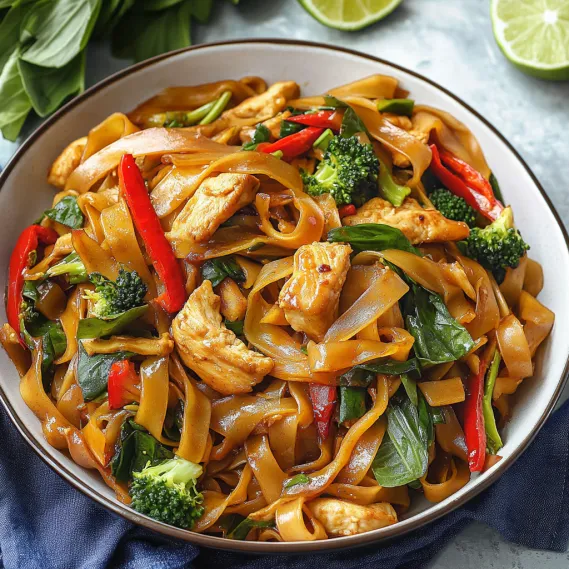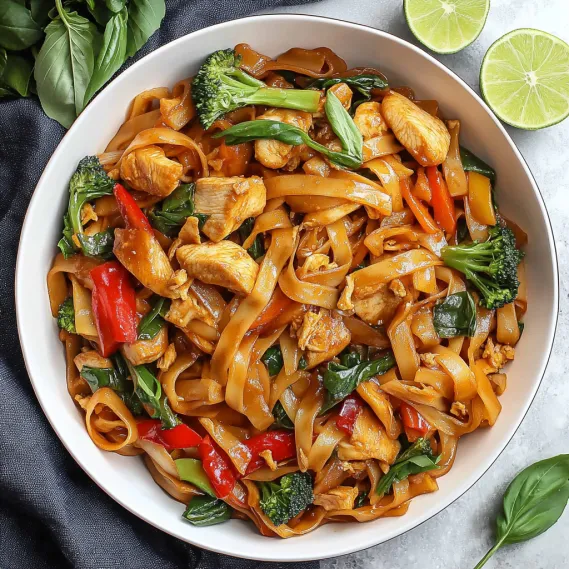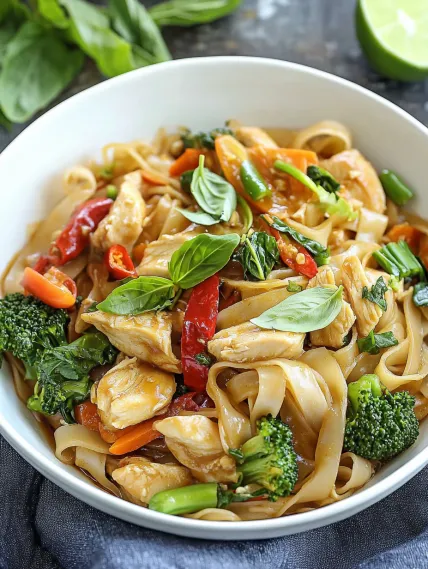 Pin it
Pin it
This Thai comfort food has become my weekend go-to whenever I'm craving bold flavors that satisfy every taste bud. Drunken Noodles might have a playful name but the rich sauce clinging to those wide rice noodles delivers serious flavor that will have everyone reaching for seconds.
I discovered this recipe during a cooking class in Thailand and have been perfecting it for years. My family now requests these noodles almost weekly whenever we need a quick dinner that doesn't compromise on flavor.
Ingredients
- Wide rice noodles: Form the hearty base of this dish soak them properly for the perfect chewy texture
- Oyster sauce: Provides rich umami depth and is worth seeking out for authentic flavor
- Dark soy sauce: Adds beautiful color and caramelized notes regular soy sauce alone cannot achieve
- Thai red chilies: Bring essential heat adjust quantity based on your spice tolerance
- Thai basil: With its anise-flavored notes is crucial for authentic flavor try growing your own in summer
- Chicken thighs: Remain juicy and flavorful even with high heat cooking preferred over breast meat
- Fish sauce: Might smell strong but adds irreplaceable savory depth do not skip this ingredient
How To Make Drunken Noodles
- Prepare the noodles:
- Soak wide rice noodles in warm water for 15 to 20 minutes until pliable but still firm. They will finish cooking later in the sauce so avoid oversoaking which leads to mushy noodles. Drain thoroughly to prevent sticking and set aside.
- Mix the sauce:
- Whisk all sauce ingredients together until sugar completely dissolves. This balanced mixture combines sweet salty tangy and umami elements. The dark soy sauce gives the final dish its signature rich color while regular soy and fish sauce provide depth of flavor.
- Stir fry aromatics and protein:
- Heat your wok until it just starts smoking then add oil. Quickly stir fry garlic and chilies for exactly 30 seconds to release their flavors without burning. Add chicken pieces spreading them out to maximize contact with the hot wok. Let them sear undisturbed for a minute before tossing.
- Add vegetables:
- Introduce vegetables to the wok based on cooking time. Onions and carrots go first followed by bell peppers and broccoli. Keep everything moving constantly to ensure even cooking while maintaining crispness. The hot wok should sizzle continuously.
- Combine noodles and sauce:
- Add drained noodles to the wok followed immediately by the sauce. Use tongs or chopsticks to gently lift and toss all ingredients. The noodles should absorb the sauce while remaining distinct not clumping together. This takes about two to three minutes.
- Finish with fresh elements:
- Turn off heat before adding Thai basil and green onions. The residual heat wilts the basil releasing its aromatic oils without overcooking. Toss quickly to distribute these fresh elements throughout the dish adding bright flavor and color.
 Pin it
Pin it
Thai basil makes this dish truly special. I grow it in pots on my patio all summer just for this recipe. The first time I successfully made this dish with homegrown Thai basil my Thai neighbor came running over asking what smelled so authentic. That moment of cultural connection through food remains one of my favorite cooking memories.
Noodle Success Tips
Perfect drunken noodles depend heavily on proper noodle preparation. Look for fresh wide rice noodles at Asian markets for the most authentic texture. These fresh noodles only need a quick rinse in warm water. If using dried stick with the widest rice noodles you can find soaking them until pliable but still slightly firm. Oversoaked noodles become mushy in the final dish. After draining toss with a tiny bit of oil if not using immediately to prevent sticking.
 Pin it
Pin it
Authentic Substitutions
No Thai basil? While Italian sweet basil works in a pinch try adding a few crushed fennel seeds to mimic the anise notes. For vegetarians tofu or seitan substitutes beautifully for chicken just be sure to press and marinate the tofu first. Cannot find Thai chilies? Serrano peppers make a good substitute though you may need to adjust the quantity. Gluten sensitive cooks can replace soy sauce with tamari and find gluten-free oyster sauce alternatives made from mushrooms.
Serving Suggestions
Serve drunken noodles immediately while still hot. The dish stands alone as a complete meal but pairs wonderfully with simple sides. Try fresh cucumber slices tossed with a bit of rice vinegar and sugar for a cooling counterpoint to the spicy noodles. For a more substantial spread add Thai fish cakes or simple steamed dumplings. Always provide lime wedges for squeezing over individual portions just before eating adding bright acidity that cuts through the rich sauce.
Cultural Context
Pad Kee Mao emerged from Thai Chinese culinary traditions becoming a beloved street food throughout Thailand. Unlike Pad Thai which was standardized as part of Thai cultural diplomacy drunken noodles vary significantly between regions and even vendors. Central Thailand versions tend to be spicier while northern interpretations might include more vegetables. The dish exemplifies Thai cooking philosophy balancing spicy savory sweet and sour elements into a harmonious whole. Modern versions like this recipe have been adapted slightly for Western kitchens while maintaining authentic flavor profiles.
Frequently Asked Questions
- → What type of noodles is best for this dish?
Wide rice noodles are traditional for drunken noodles and work best as they absorb the sauce while retaining a chewy texture.
- → Can I use a different protein instead of chicken?
Yes, you can substitute chicken with shrimp, beef, tofu, or even a mix of your favorite proteins for variation.
- → How do I adjust the spice level?
You can increase or decrease the number of Thai chilies to match your spice tolerance, or omit them entirely for a milder dish.
- → What makes Thai basil essential in this recipe?
Thai basil adds a unique peppery and slightly anise-like flavor that enhances the overall taste of the dish. Sweet basil can be used as a substitute.
- → Can I prepare this dish ahead of time?
Drunken noodles are best served fresh, but you can prepare the sauce and chop the vegetables ahead of time for quicker assembly.
- → What are tips for preventing noodles from breaking?
To prevent breaking, gently toss the noodles with the sauce and ingredients rather than over-stirring during cooking.
